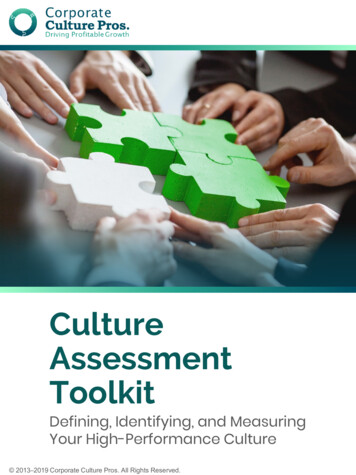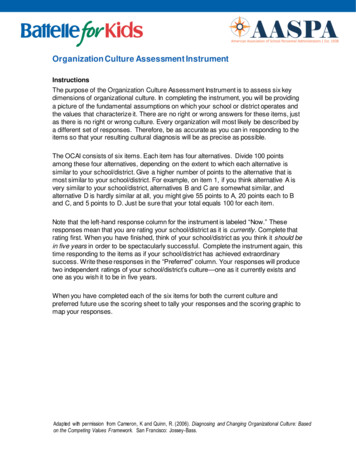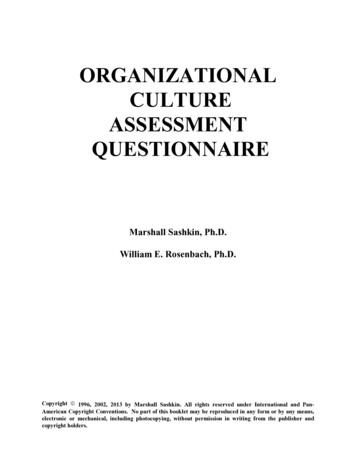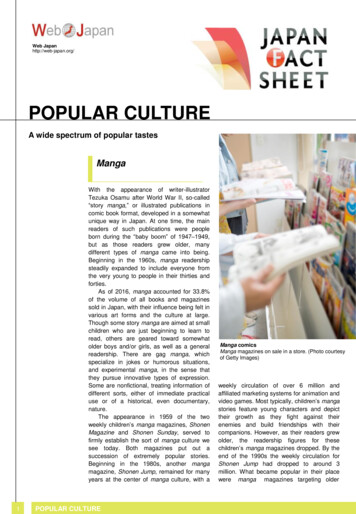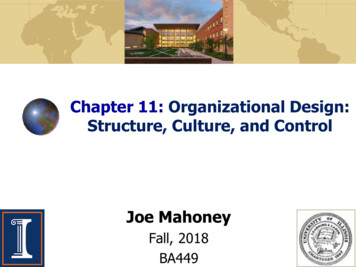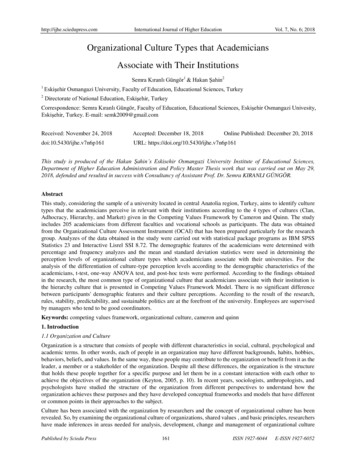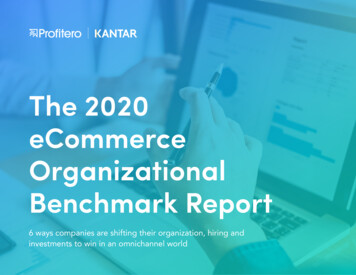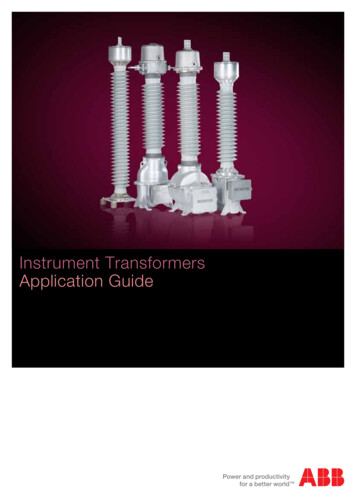
Transcription
ReportOrganizational CultureAssessment InstrumentCompanyXJune 21, 2019
2Table of ContentsThe Organizational Culture Assessment Instrument (OCAI) Introduction 4The Competing Values Framework 4The culture types 6The OCAI assessment 8Working with your OCAI culture profile 9Results CompanyX 12The dominant culture 12Discrepancy between current and preferred culture 13Cultural Congruence 13Dominant Characteristics 15Organizational Leadership 16Management of Employees 17Organization Glue 18Strategic Emphases 19Criteria of Success 20Congruence 21Results Demographic1 22The dominant culture 22Discrepancy between current and preferred culture 23Six aspects of culture 24Congruence 30Results Demographic2 31The dominant culture 31Discrepancy between current and preferred culture 32Six aspects of culture 33Congruence 39Results Demographic3 40The dominant culture 40Discrepancy between current and preferred culture 41Six aspects of culture 42Congruence 48 2019 OCAI online
3Results Demographic4 49The dominant culture 49Discrepancy between current and preferred culture 50Six aspects of culture 51Congruence 57Comparison of the results 58Next steps: OCAI Workshop and the Culture process 61How to stimulate the Create / Adhocracy Culture 62How to stimulate the Collaborate / Clan Culture 63How to stimulate the Control / Hierarchy Culture 63How to stimulate the Compete / Market Culture 64Appendix: OCAI-questionnaire 66 2019 OCAI online
4The Organizational Culture AssessmentInstrument (OCAI) IntroductionWelcome to this report with your Culture Profiles! Please read this Introduction as itwill help you understand and work with your results.Culture influences organizational performance, innovation, agility, engagement, andcompetitiveness. Research shows that a toxic culture decreases productivity with 40%,while an effective culture increases productivity with 20%, and a positive culture evenwith 30-40%. Your OCAI culture profiles are an insightful start to developing yourorganizational culture.The Organizational Culture Assessment Instrument (OCAI, Kim Cameron) is avalidated tool for assessing organizational culture, developed by Robert Quinn andKim Cameron at the University of Michigan. It is based on the Competing ValuesFramework: one of the most useful frameworks in business and used by over 10,000companies in 30 years (ten Have, 2003).The Competing Values Framework (CVF) is validated by the research of Denison,1990; Howard, 1998; Deshpande & Farley, 2004. It corresponds with other dimensionsthat describe how people behave when organizing (Linnenluecke, 2010; Ralston, Tong,Terpstra, Wang & Egri, 2006; Cameron & Quinn, 2006). It aligns with the biologicaldrives in the brain: the need to bond, to learn, to acquire, and to defend. (Paul Lawrence,Nitin Nohria, 2002). The CVF can also be related to the “Big Five” personality traits,the MBTI, and the four psychological types discovered by Carl Gustav Jung.The Competing Values Framework consists of four Competing Value sets thatcorrespond with four types of organizational culture. Every organization has a uniquemix of the four culture types. Quinn and Cameron’s extensive research showed thatmost organizations develop a dominant culture.The OCAI is a well-researched and validated culture assessment, but also compact withsix aspects that reliably represent an organization’s culture.The Competing Values FrameworkThe CVF emerged from research to identify the organizational effectiveness criteria 2019 OCAI onlineTOC
5(Quinn & Rohrbaugh, 1981). The criteria that were found to make a difference are thedimensions internal-external, and stability-flexibility.An organization might have an internal orientation; focusing inward on development,collaboration, integration of activities, coordination. The opposite is an externalorientation; looking at the market, what’s possible with the latest technology, whatcompetitors are doing, what customers want, and it could diversify activities as a result.Both internal and external attention is needed to be successful in the long run - butdepending on their environment an organization will have a dominant preference. Anactive, volatile market calls for an external orientation whereas a stable environmentallows an internal focus.The second defining dimension is the focus on stability or flexibility — organizationsthat prefer stability value clear structures, planning, budgets, and reliability. Organizations that value flexibility, strive to adapt quickly to changing circumstances - focusingmore on people and activities than on structure, procedures, and plans.Note the “competing” nature of the values: organizations focus on the inside or theoutside - but cannot do both at the same time. The same goes for stability and flexibility.Organizations can spend their money, attention, and time only once, so they tend toemphasize one value set over the other.However, Quinn and Cameron found that the most effective organizations use all fourvalue sets when necessary and they can show contradictory behavior. Most organizationshowever have a focused repertory of values and behaviors and a dominant culture type.What is the best culture type for your organization? A culture type works best in theactivities domain that aligns with its values. In the health care sector, for instance, weoften see Collaborate or Clan culture.However: there is no ultimate “best” organizational culture prescribed by the CompetingValues Framework. The model is descriptive, not normative!In a specific domain or market, one culture type might fit better than another, and thisis for the organization to decide. “When would be at our best - given our clients, ouremployees, our challenges, our resources?” This is an important question to answer whenyou work with your OCAI Profile. (Read more below). 2019 OCAI onlineTOC
6Flexibility and discretionClanAdhocracyInternal focus and integrationExternal focus and differentiation5040302010HierarchyMarketStability and controlThe culture typesThe two dimensions of “competing values” combined create four culture types: thedynamic, entrepreneurial Create Culture, the people-oriented, friendly CollaborateCulture, the process-oriented, structured Control Culture and the results-oriented,competitive Compete Culture. Also known as Adhocracy, Clan, Hierarchy and Marketculture (Cameron & Quinn).The Create / Adhocracy CultureA dynamic, entrepreneurial, and creative place to work. The leaders are consideredinnovators and risk takers, and so are employees. They share a commitment to experimentation and innovation. Prominence is emphasized. The long-term goal is to growand create new resources. The availability of new products or services is seen as a success.The organization values individual initiative and freedom.Typical examples in sectors like start-ups, technology-driven industries (communications, sustainability), and services like Airbnb, Uber.Leader Type: innovator, entrepreneur, visionary.Value Drivers: innovative outputs, transformation, agility.Theory for Effectiveness: innovativeness, vision, and new resources produce effectiveness.Quality Strategies: surprise and delight, create new standards, anticipate needs,continuous improvement, find creative solutions, “fail fast forward”. 2019 OCAI onlineTOC
7The Collaborate / Clan CultureThis working environment is friendly. People have a lot in common, and it feels like alarge family. The leaders are seen as mentors or maybe even father figures. The organization values loyalty and tradition. There is great involvement. They emphasize long-termHuman Resource Development. Success is defined within the framework of addressingthe needs of the clients and caring for the people. The organization promotes teamwork,participation, and consensus.Typical examples in sectors like health care, education, some government agencies,not-for-profits.Leader Type: facilitator, mentor, team builder.Value Drivers: commitment, communication, development.Theory for Effectiveness: human development and participation produce effectiveness.Quality Strategies: empowerment, team building, employee involvement, HumanResource development, open communication.The Control / Hierarchy CultureThis is a formalized and structured workplace. Procedures direct what people do. Leadersare proud of efficiency-based coordination and organization. Keeping the organizationfunctioning smoothly is most crucial. Formal rules and policies keep the organizationtogether. The long-term goals are stability and results, paired with efficient and smoothexecution of tasks. Reliable delivery, continuous planning, and low cost define success.Personnel management has to guarantee work and predictability.Typical examples in sectors like medicine, nuclear power, military, government, bankingand insurance, transportation.Leader Type: coordinator, monitor, organizer.Value Drivers: efficiency, punctuality, consistency, and uniformity.Theory for Effectiveness: control and efficiency with appropriate processes produceeffectiveness.Quality Strategies: error detection, measurement, process control, systematic problemsolving, quality tools.The Compete / Market CultureThis is a results-based workplace that emphasizes targets, deadlines, and getting thingsdone. People are competitive and focused on goals. Leaders are hard drivers, producers, 2019 OCAI onlineTOC
8and rivals. They can be tough with high expectations. The emphasis on winning keepsthe organization together. Reputation and success are the most important. Long-termfocus is on rival activities and reaching goals. Market dominance, achieving yourgoals, and great metrics are the definitions of success. Competitive prices and marketleadership are important. The organizational style is based on competition.Typical examples in sectors like consultancy, accountancy, sales and marketing, services,manufacturing.Leader Type: hard driver, competitor, producer.Value Drivers: market share, goal achievement, profitability.Theory for Effectiveness: aggressive competition and customer focus produceeffectiveness.Quality Strategies: measure customer preferences, improve productivity, create externalpartnerships, enhance competitiveness, involve customers and suppliers.The OCAI assessmentThe scientific basis of this culture assessment is excellent, but what is best is its practicalapplicability. The CVF helps you see what people value and emphasize when theyorganize activities, and, thus, what type of culture prevails. By comparing the currentwith the preferred culture, you’ll see where the organization currently is and wher
The Organizational Culture Assessment Instrument (OCAI) Introduction Welcome to this report with your Culture Profiles! Please read this Introduction as it will help you understand and work with your results. Culture influences organizational performance, innovation, agility, engagement, and competitiveness. Research shows that a toxic culture decreases productivity with 40%, while an .

